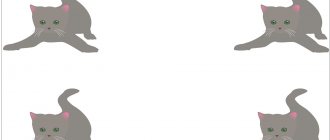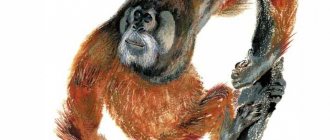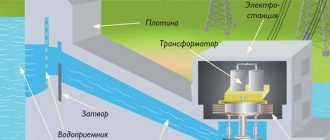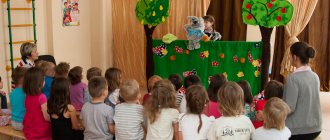Abstract of GCD in the senior group “What do we know about water, they say it’s everywhere”
Description of material:
I bring to your attention a summary of the educational activity on familiarization with the outside world with elements of experimentation for children of the older group on the topic: “What do we know about water, they say it is everywhere.” This material will be useful to teachers of the senior group. This is a summary of an educational and research lesson aimed at expanding children's knowledge about water and developing curiosity in preschoolers.
Integration of educational areas:
“Cognition”, “Communication”, “Socialization”, “Cognitive-research”, “Reading fiction”, “Productive”.
Target:
generalize children's knowledge about water.
Tasks:
Educational:
Expand children's understanding of the properties of water, the importance of water in the life of animals, plants and humans, and its role in nature. Teach children to conduct simple experiments with water. To give children an understanding of why water sometimes needs purification and to give a basic understanding of the filtration process.
Educational:
Develop thinking, attention, memory, ability to analyze and observe. Develop skills in conducting laboratory experiments and curiosity.
Speech:
Develop coherent speech, enrich children's vocabulary: evaporation, filters, filtration, wastewater treatment plants, the water cycle in nature.
Educational:
To instill in children a careful attitude towards water, to develop skills in everyday environmental behavior in relation to water supplies.
Demo material:
illustrations depicting the planet’s water resources (rivers, lakes, seas, oceans); demonstration poster “Water cycle in nature”; box “with a riddle (piece of ice)”; a pre-cut balsam sprig in a glass of colored water; distribution with objects - an apple, a small fresh fish, a sprig of balsam, a slice of watermelon; bucket of water.
Handout:
for experimental work - mirrors, pieces of cotton wool and gauze, funnels, plastic glasses, two per child, water from the river, aprons and hats, for games - paper masks for children with drawings of droplets, one mask with the image of the Sun, and one with the image -Clouds.
Methodical techniques:
Organizational moment, game situation, conversation-dialogue, examination of illustrations, conversation, experimentation, creation of a problem situation, physical education minute-didactic game, analysis, summing up.
GCD move:
Children are included in the group. Educator:
- Good morning, I tell you, Good morning!
I love you all! I wish you to study well. Listen carefully, gain your mind. — Guys, I have prepared interesting riddles for you. Here's the first riddle. Go to the table (the children find a box on the table with a round hole on the side). - Touch with one hand what lies inside the box, but do not tell the answer, keep it secret (“in your fist”). - Here is the second riddle - a sound one (the sound of the sea surf, the splash of waves). - Now tell me: what was in the box and what sounds did you hear? What will we talk about in today's lesson? (children's answers). - Yes, that’s right, there was a piece of ice in the box, which in your palms quickly turned into water and the sounds of the sea surf are also familiar to you. Today's lesson will focus on water. Educator:
Have you heard about water? They say she is everywhere! In a puddle, in the sea, in the ocean And in a water tap Like an icicle freezes, It creeps into the forest with fog It’s boiling on our stove, The steam of the kettle hisses. Without it, we can’t wash ourselves, we can’t eat, we can’t get drunk! I dare to report to you, We cannot live without water. (N. Ryzhova)
- What do you guys think, why can’t all living things survive without water? (children's answers). - That's right, they also say about water - water - resin, that is, water is life. Now go to the table and let's see what's on it (on the table there is an apple, fresh fish, a sprig of balsam and a picture of a watermelon). Educator:
- Today we are talking about water, and what does what is in front of you have to do with water (full answers from children).
- I agree with you, watermelon contains a lot of juice, that is, water, an apple also contains juice. Water is the habitat of fish. If we crush the cut stem of a balsam sprig with our fingers, we will feel the moisture. And the leaves also contain water. Where? Why? - Yes, that’s right, we water the flowers with water, the plant’s roots absorb the water and it flows through the stem into the leaves. And balsam is popularly called “Vanka-wet”, since before the rain numerous drops of water appear along the edges of the leaves. To confirm this, consider the experiment we conducted earlier. A sprig of balsam was placed in a jar of red-colored water. -What did you notice? (children's answers). The stem and leaves turned yellow. This proves that the plant needs water, the plant “drinks” the water and it travels along the stem to the leaves. Educator:
- Now I ask you to close your eyes and see what has changed?
(exchanges fresh fish for dry). - You correctly noticed that the fish became dry, there was no water in it. Where did the water go? (children's answers). - That's right, the water evaporated, that is, turned into steam. - Give examples when you observed the evaporation of water? (Mom hangs the laundry out on the balcony after washing and it becomes dry, wipes the table with a wet rag, washes the floors). - And now I suggest you play an interesting game “Droplets Are Walking in a Circle.”
But for this you need to turn into small droplets (music reminiscent of rain sounds, the teacher asks the children to put on droplet masks, she puts on the cloud mask and the game begins).
Educator: I am Tuchka’s mother, and you guys are my droplet children, and it’s time for you to hit the road. (Music.) The droplets jump, run, and dance. Droplets flew to the ground. Let's jump and play. They got bored jumping around alone. They gathered together and flowed in small cheerful streams. (The droplets form a stream, holding hands.) The streams met and became a big river. (The streams are connected into one chain.) Droplets float in a large river and travel. The river flowed and flowed and ended up in the ocean (children form a round dance and move in a circle). The Droplets swam and swam in the ocean, and then they remembered that Mother Cloud told them to return home. And then the sun just warmed up. The droplets became light and stretched upward (crouched droplets rise and stretch their arms upward). They evaporated under the rays of the sun and returned to my mother, Tuchka. Well done, droplets, they behaved well, they didn’t get into passers-by’s collars or splash themselves. Now stay with me, I miss you. - Now we will draw a conclusion: the sun heats the earth, water, when it heats up, rises, there it cools and falls in the form of rain, snow, back to the earth, into rivers, seas, oceans. This phenomenon in nature is called the water cycle in nature. Let's all repeat it in unison (we look at the poster “The Water Cycle in Nature”). Water evaporates from the surface of the earth under the influence of the sun, forms clouds, and returns to the earth in the form of rain and snow. The water cycle in nature occurs every day, at any time of the day, in any weather, at any time of the year. — Let's continue talking about water. We are talking about the fact that all living things need water and are made of water. - Tell me, is there liquid in a person? What proves that we have water in us? (children's answers). - Yes, I completely agree with you, these are tears, drool, sweat, blood. And to make sure of this once again, we will go to the girls’ play corner and use the small mirrors from the box. Educator:
- Take the mirrors in your hands, breathe on them with your mouth slightly open and immediately touch the mirror. What do you feel? (children's answers). - Yes, my finger became wet. This experience proves that a person has water in him and when he breathes, he loses it. Let's go to the laboratory again (put on aprons and caps). — Before we start work, here’s another question: where do we get water? (children’s answers). - How does she get into our house? (through pipes, from the river). - Guys, have you seen what kind of water flows in the river? (cloudy, dirty, dark). — What kind of water flows from the tap? (clean, transparent). - What kind of transformation happens to water? (it is cleaned). — To get into the tap, water is purified by many machines and devices. Every major city has treatment facilities in which incoming water from the river undergoes special treatment, after which clean water is supplied through pipes to residents’ homes. And many of you have filters for water purification at home (look at the illustrations). Thus, you and I drink clean water. - So, in front of you in glasses is water from our Volga River. Through the walls of the glasses you can see that the water from the river is dirty. And we will try to purify the water in our laboratory. The first thing we'll do is make filters. To do this, take a piece of cotton wool and a piece of gauze, folded in four layers. Place cotton wool and gauze in a funnel. Place the funnel in a clean glass. We will pour dirty water from the river in a thin stream into a funnel with a filter. — Can you see through the transparent walls of the glass that the water has become cleaner? But you can’t drink this kind of water yet. And to achieve even better results when purifying water, you can add, for example, coal to a glass of purified water. Leave for a while and filter the water again. Such water will be considered well purified. But how much time we spent purifying just a few glasses of water. And adults, those who work at wastewater treatment plants, have to spend a lot of effort, money and time to obtain clean water. Therefore, water must be conserved and treated with care.
A river flows from afar, A river flows from afar, How beautiful and deep, Or maybe it’s the ocean? Preschooler Ivan Sidorov forgot to turn off the tap in the kitchen.
— Guys, today we brought a bucket of water with us to class. This is water that dripped overnight from a slightly open tap. Where do we put this water? (water the flowers, wash the toys, wash the doll’s clothes). That’s right, we will treat water with care. And so that you always remember this, we will hang this sign (a crossed out faucet with a drop of water) in the washroom. — Let’s invite our guests to listen to tips on how to save water (children’s answers: don’t waste water; close the tap tightly; don’t play with water that flows from the tap; don’t leave taps open unnecessarily). Well done guys, your advice is very important. - And now I invite you to remember everything that you learned about water in today’s lesson (the children, together with the teacher, recall bright and interesting moments, answer questions, sum up the lesson).
Author: Kazantseva Tatyana Aleksandrovna
teacher, MDOU Novoulyanovsky general development kindergarten “ABVGDeyka” Novoulyanovsk, Russia The article is published in the author’s edition
Summary of a conversation with children of senior preschool age “The benefits of water”
Lesson summary “How important water is”
Purpose of the conversation:
formation of children's ideas about water and its role on Earth.
Tasks:
— consolidate children’s knowledge of why water is needed;
- develop coherent, dialogical and monologue speech of children, activate children’s vocabulary; continue to teach children to listen to a question to the end;
— cultivate cultural and hygienic skills; careful attitude towards water. Equipment:
globe, laptop, screen, projector, cards for the game “What will happen if the water disappears?”, magnetic board, flat images of the globe, basket for drawings, blue long ribbons and short and long ribbons.
Progress of the lesson
TEACHER
asks the children a riddle.
In the sea I am always salty,
but in the river I am fresh. Only in the hot desert I have no place at all
(water).
Water
- one of the most amazing substances on the planet.
TEACHER.
Water is needed to do many simple, everyday things.
She is irreplaceable. Do you think it is possible to live without water? Without water, a person cannot live long. TEACHER.
Is there anything else you would like to know about water?
Then you and I are going to the city of Knowledge (shows the globe to the children). TEACHER.
Do you know what this is?
(children's answers). TEACHER.
This is a globe - a model of planet Earth.
What is indicated in blue on the globe? (children's answers). TEACHER.
What other colors do you see?
What do these colors represent? (land). What color is there more on the globe? (twists the globe) What do you think this means? (children's answers). There is much more water on our planet than land. TEACHER.
Where in nature is there water?
CHILDREN.
In the seas, oceans, rivers, lakes.
TEACHER.
How are they different and what do they have in common?
(children's answers). TEACHER.
Is it possible to drink water from the sea and ocean?
Sea water contains many different salts that are produced by algae. It is useful to take baths with sea water and gargle with it. It strengthens the body, but is not suitable for drinking. What kind of water can you drink? (children's answers). We need clean, fresh water for drinking, cooking, and bathing. Where does fresh water come from? River water is called fresh water. River water is purified in a special place called a water treatment plant, after purification it enters our apartments through water taps. TEACHER.
Where is there more water - in the oceans or in rivers and lakes? What conclusion can be drawn from this? (Water must be conserved because there is little fresh water on Earth).
Physical education minute.
We quickly went down to the river,
bent down and washed ourselves. One, two, three, four - That's how nicely refreshed you were! And now we swam together, You need to do this with your hands: Together - once, this is breaststroke, One, the other - this is crawl. We swam along the river together, came out to the steep bank and waved our hand to her!
Game: “What happens if the water disappears?”
Let's imagine that the water on earth has disappeared. What will happen to plants, animals, humans?
Children's answers.
TEACHER.
Water is of great importance for life.
All living beings need it - animals, plants and people. It seems that there is a lot of water on earth, but clean water is becoming less and less. Why do you think this is happening? Children's answers. TEACHER
.
People break the rules of behavior in nature. Water bodies are polluted not only by garbage, but also factories and factories pollute rivers with waste from their production. Aquatic life is dying from this. The sea coasts are strewn with garbage, people dump huge amounts of toxic substances into the seas and oceans, tanker accidents leave sticky oil slicks on the surface of the water, all this is destroying the water. There are countries on the planet where clean water is no longer enough, so on March 22, people all over the planet celebrate World Water Day. His motto: “Water is life.” We must conserve water so that there is enough for everyone. TEACHER.
What measures need to be taken to ensure that the water does not leave us and is clean?
CHILDREN.
Don't throw trash.
You must treat water with care and do not leave taps open. Keep rivers, lakes, seas, ponds clean and tidy, and do not litter natural bodies of water. Install water purifiers. TEACHER.
There are many different rivers on earth - they are big and small, and they all run somewhere, a big river is formed from many small rivers and streams.
And it is very important to preserve the water of small and large rivers from pollution. TEACHER.
Let us draw clean oceans, seas, rivers and hang the drawings on the board so that they remind us of the need to save water. TEACHER.
What wonderful drawings you have made.
What would you like to say to other people00? CHILDREN'S ANSWERS
(People, plants, animals, birds need water. Our earth and all life on it will die without water. Water in both rivers and seas must be preserved and protected so that disaster does not happen).




